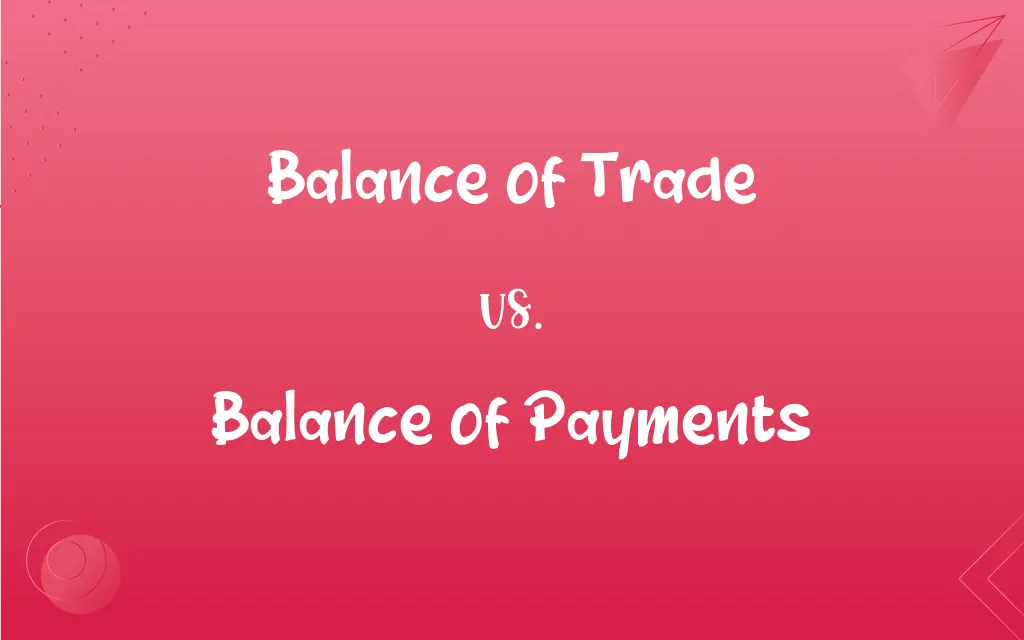Balance of Trade vs. Balance of Payments: What's the Difference?
Edited by Aimie Carlson || By Janet White || Published on November 2, 2023
Balance of Trade measures the difference between exports and imports of goods, while Balance of Payments encompasses all economic transactions between a country and the rest of the world.

Key Differences
Balance of Trade refers to the difference in value between a country's total exports and imports of goods. A positive balance indicates a surplus, meaning a country exports more than it imports. In contrast, the Balance of Payments is a broader concept that records all economic transactions, including trade, investments, and financial transfers, between a nation and other countries.
When analyzing a country's economic health, Balance of Trade can give insights into its competitiveness in international goods markets. It focuses solely on tangible goods. However, Balance of Payments offers a more comprehensive view, including services, financial flows, and capital movements, providing a clearer picture of a country's economic relationships and standings.
A country can have a favorable Balance of Trade, showcasing a trade surplus, but it might simultaneously have an unfavorable Balance of Payments due to significant outflows of capital or heavy borrowing from foreign sources.
Balance of Trade is just one component of the current account in the Balance of Payments. While the former might show positive or negative figures indicating trade surpluses or deficits, the latter takes into account numerous other factors, ensuring a balance since every transaction recorded as a debit has a corresponding credit.
Observing the Balance of Trade is essential for understanding trade policies and their implications. In contrast, Balance of Payments helps policymakers assess a country's financial stability, external vulnerabilities, and the effectiveness of its economic policies.
ADVERTISEMENT
Comparison Chart
Focus
Exports and imports of goods
All economic transactions with foreign entities
Components
Goods only
Goods, services, financial flows, capital movements
Indication
Trade surplus or deficit
Overall economic relationship and financial stability
Scope
Narrow (part of the current account)
Comprehensive (includes current, capital, financial accounts)
Utility
Assesses trade competitiveness
Assesses economic policy effectiveness and vulnerabilities
ADVERTISEMENT
Balance of Trade and Balance of Payments Definitions
Balance of Trade
The value difference between exported and imported goods.
Countries often aim to achieve a favorable Balance of Trade to strengthen their economies.
Balance of Payments
Reflects a country's external economic and financial position.
A country's sustainable economic growth is often linked to a stable Balance of Payments.
Balance of Trade
An indicator of a nation's goods market competitiveness.
By analyzing the Balance of Trade, policymakers can understand trade patterns and dependencies.
Balance of Payments
A record of all economic transactions between residents of a country and the rest of the world.
The Balance of Payments helps gauge a nation's overall economic relationships and financial health.
Balance of Trade
A component of the current account detailing trade in goods.
When assessing economic health, both the Balance of Trade and other financial transactions are considered.
Balance of Payments
An accounting of a country's total economic dealings with foreign entities.
A negative Balance of Payments might indicate more money is leaving the country than coming in.
Balance of Trade
A measure of a country's trading strength in the global market.
A consistent negative Balance of Trade might indicate an over-reliance on imported goods.
Balance of Payments
A comprehensive account detailing trade, financial flows, and capital movements.
Policymakers often refer to the Balance of Payments to determine economic policy adjustments.
Balance of Trade
The net difference between a country's exports and imports of goods.
A positive Balance of Trade indicates that a nation exports more goods than it imports.
Balance of Payments
Encompasses the current, capital, and financial accounts of a nation.
By examining the Balance of Payments, one can identify areas of strength and vulnerability in an economy.
FAQs
How comprehensive is the Balance of Payments?
Balance of Payments provides a holistic view of all economic transactions between a country and foreign entities.
Why is Balance of Payments always balanced?
Balance of Payments balances out since every transaction recorded as a debit has a corresponding credit.
How does Balance of Trade impact an economy?
Balance of Trade can indicate a country's competitiveness in global goods markets and its reliance on imports or exports.
What factors might negatively affect the Balance of Payments?
High foreign debt, significant capital outflows, or a large trade deficit can negatively influence a country's Balance of Payments.
Can a country have a positive Balance of Trade but a negative Balance of Payments?
Yes, a favorable Balance of Trade can coexist with an unfavorable Balance of Payments due to factors like capital outflows.
Is the Balance of Trade the same as the trade balance?
Yes, Balance of Trade is often referred to as the trade balance.
What components are included in the Balance of Payments?
Balance of Payments includes goods, services, financial flows, and capital movements, unlike the goods-only focus of Balance of Trade.
Which account in the Balance of Payments does the Balance of Trade belong to?
The Balance of Trade is a component of the current account in the Balance of Payments.
How can a country improve its Balance of Trade?
A country can enhance its Balance of Trade by increasing exports, reducing imports, or a combination of both.
Is the Balance of Payments influenced by foreign investments?
Yes, foreign investments play a significant role in a country's Balance of Payments.
Why is a consistent trade deficit a concern?
A consistent negative Balance of Trade can lead to debt accumulation, currency devaluation, and economic dependency.
What does the Balance of Trade measure?
Balance of Trade measures the difference between a country's exports and imports of goods.
Which is broader in scope, Balance of Trade or Balance of Payments?
Balance of Payments has a broader scope, encompassing all economic transactions with foreign entities, compared to the goods-only Balance of Trade.
Can a country manipulate its Balance of Trade?
Countries can influence their Balance of Trade through trade policies, tariffs, and currency manipulations.
How do remittances from abroad affect the Balance of Payments?
Remittances are recorded as credits in the current account of the Balance of Payments.
How are exchange rates connected to the Balance of Payments?
Exchange rates can affect trade competitiveness, capital flows, and foreign investments, directly influencing the Balance of Payments.
Do financial markets influence the Balance of Payments?
Financial markets directly affect the financial account within the Balance of Payments.
How do interest rates impact the Balance of Payments?
Interest rates can influence foreign capital flow, thus affecting the capital and financial accounts of the Balance of Payments.
Why is monitoring the Balance of Payments important for policymakers?
Policymakers use the Balance of Payments to assess financial stability, identify vulnerabilities, and guide economic policies.
Can services influence the Balance of Payments?
Yes, unlike the Balance of Trade, the Balance of Payments includes trade in services.
About Author
Written by
Janet WhiteJanet White has been an esteemed writer and blogger for Difference Wiki. Holding a Master's degree in Science and Medical Journalism from the prestigious Boston University, she has consistently demonstrated her expertise and passion for her field. When she's not immersed in her work, Janet relishes her time exercising, delving into a good book, and cherishing moments with friends and family.
Edited by
Aimie CarlsonAimie Carlson, holding a master's degree in English literature, is a fervent English language enthusiast. She lends her writing talents to Difference Wiki, a prominent website that specializes in comparisons, offering readers insightful analyses that both captivate and inform.








































































